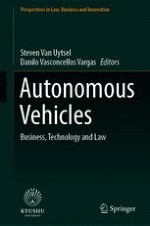2021 | OriginalPaper | Chapter
Technology in the Driver’s Seat: Legal Obstacles and Regulatory Gaps in Road Traffic Law
Author : Kiliaan A. P. C. van Wees
Published in: Autonomous Vehicles
Publisher: Springer Nature Singapore
Activate our intelligent search to find suitable subject content or patents.
Select sections of text to find matching patents with Artificial Intelligence. powered by
Select sections of text to find additional relevant content using AI-assisted search. powered by
